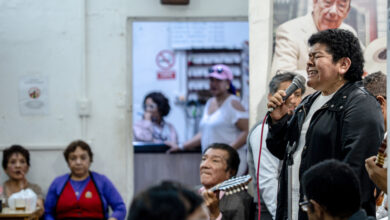The trend that could favor Keiko Fujimori
Recent elections in Latin America give some hope to the Fuerza Popular candidate.

In recent years, it has been possible to see two recurring phenomena in the politics of the continent. Photo: TW-KeikoFujimori
LatinAmerican Post | Santiago Gómez Hernández
Listen to this article
Leer en español: La tendencia que podría favorecer a Keiko Fujimori
In recent years, it has been possible to see two recurring phenomena in the politics of the continent. First of all, the outsider candidates. These are characters outside politics and who start a campaign for public office far from the establishment, which is so questioned in almost all current democracies. They share similarities such as a politically incorrect discourse and ideals previously seen as extremists, but which today sell them as sincere and close characters to their polarized public. Candidates such as Donald Trump, Jair Bolsonaro, Rafael López Aliaga, among others, stand out from this group. Many of them have managed to win the elections and, in the most recent cases (but not exclusively) aligned with the values of the right.
In the other corner are the political career candidates. In most cases, they are familiar faces to the majority of the politically active population. Recently, a particular phenomenon has occurred: many of these longtime politicians who had previously been defeated in elections, have managed to win the presidency on their third attempt. Like Keiko Fujimori in these elections, Andrés Manuel López Obrador and Guillermo Lasso only achieved the presidency in their third attempt.
Also read: Biggest winners and losers after the Peruvian elections
Manuel López Obrador, an eternal candidate for president
Before becoming president of the United Mexican States, AMLO (as he is known) was no stranger to national politics. On two occasions, the leftist politician had tried to reach the National Palace. However, Felipe Calderón, (PAN) first, and Enrique Peña Nieto (PRI), second, demonstrated the power of the Mexican bipartisan system and how difficult it would be to defeat it.
"La tercera es la vencida": el largo camino que ha recorrido AMLO para intentar llegar a la presidencia de México https://t.co/JWunDHw0s6
— BBC News Mundo (@bbcmundo) June 25, 2018
In the 2006 elections, AMLO was launched by the Coalition for the Good of All, an alliance between the Party of the Democratic Revolution, the Labor Party, and the Convergence party. In that year, López Obrador (35.29%) was in second place, less than 250 thousand votes from Calderón (35.91%). Despite leading all the polls close to the elections, he had to settle for second place.
Six years later, he ran again for the presidency. In those elections, despite obtaining more than one million votes, in relation to the past ones, he was again in second place, this time against the PRI candidate, Enrique Peña Nieto, by more than 3 million votes below. This year, the polls always favored Peña Nieto.
For 2018, he took advantage of the discredit of both the PRI and PAN parties and swept 30,113,483 votes, more than double that of his persecutor, Ricardo Anaya of the National Action Party. His coalition Juntos Haremos Historia (Morena, Encuentro Social and PT) also won a majority in Congress.
Ecuador: the end of correísmo
This same month of April, and despite not winning the first round, Guillermo Lasso got the majority of the votes in the second round, beating Andrés Arauz, the correista candidate. This victory of the right-wing politician only came after 2 consecutive defeats.
In 2013, Lasso was defeated by Rafael Correa, who thus achieved his third term. Correa, at that time, won with more than 57% in the first round. From the polls, the socialist leader took unattainable advantages that reflected his great popularity.
Four years later, Lasso faced the correista candidate, Lenin Moreno. Despite the fact that this time, the elections were much closer, and Lasso managed to reach the second round, Moreno would end up getting 51.16% of the vote, compared to 48.84% in the repetition of the polls.
Guillermo Lasso no reconoce la victoria de Lenín Moreno https://t.co/3KNfxm5shA #Elecciones2017 #Ecuador pic.twitter.com/dkMhSA7G44
— El Universo (@eluniversocom) April 19, 2017
It was only until the third attempt that Lasso managed to defeat Correismo with 52.36% of the votes in the second round, compared with 47.64% for Arauz. This, after almost not being second in the first round, when he surpassed by only 0.35% of the vote the indigenous leader, Yaku Pérez. Lasso benefited from the anti-government vote and the null support Arauz received from Pérez.
Keiko Fujimori: The third is the loser?
As we have already seen, the daughter of the Peruvian dictator Alberto Fujimori could repeat this trend that happened in Ecuador and Mexico. Like Lasso and AMLO, Keiko Fujimori has just finished second in the last two elections.
In 2011 he lost the presidency in the second round by less than half a million votes. At the time, Ollanta Humala of the Peruvian Nationalist party won in the first and second rounds.
Five years later, Fujimori managed to win the first round and, despite obtaining 6,115,073 votes (almost double that of Pedro Pablo Kuczynski -PPK-), he did not pass 50% and had to compete in the second round. Already in the repetition, 41 thousand votes distanced her from PPK and she did not manage to reach the presidency.
Now, Keiko arrives as in 2011, second in the first round elections, but the political crisis that Peru is experiencing makes it impossible to predict any clear victory. However, for now, polls give Pedro Castillo an 11 percentage point lead over Keiko. The former first lady (a position she held during her father's presidency) only has the cases of Mexico and Ecuador, and more than a month of campaign as an incentive that she can defeat the leader of Peru Libre.




